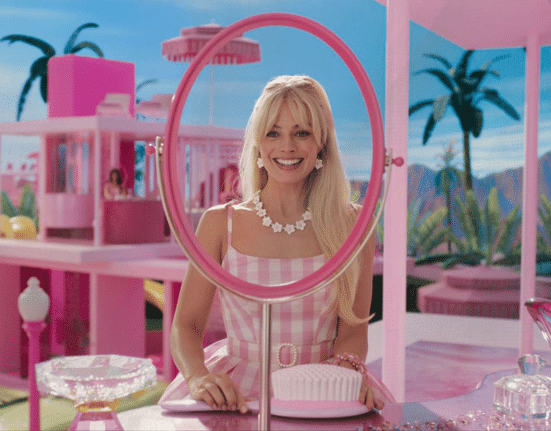WARNING: This review contains spoilers.
★ ★ ★ ★ ☆
WHEN news about a live-action Barbie film came out, everybody was ecstatic and looking forward to the hot pink world that well-celebrated indie director Greta Gerwig would produce.
While many thought the film would just be a long feature about the bestselling doll, there are others who hoped it would be deep and edgy since the Lady Bird director is onboard and she has been widely known for her passionate take on feminism and gender-equity.
Screened worldwide on Wednesday, Barbie, which stars Margot Robbie in the titular role and Ryan Gosling as Ken, is a comical, fierce, and deeply feminist film that dares its audience to laugh and cry even for those who are made of plastic.

Courtesy: Warner Bros.
Directed by Gerwig and based on the screenplay she wrote with Noah Baumbach, the movie strived to explore Barbie’s intricate life while keeping things funny and clever.
While it delves into the central theme that the original toy exudes, which is that girls can do anything, it also pokes fun at patriarchy and the toy’s manufacturer Mattel.
And even with the neon pink buzz that will undoubtedly evoke nostalgia, Barbie did not fail in reminding its audience the same message it has been conveying since we were kids — which is that we must be comfortable with who we are and who we want to be.
Barbie at a glance
The film begins with an eccentric and satirical narration about the popular toy.
“Thanks to Barbie, all problems of feminism and equal rights have been solved,” it said.
Then, it transports the audience to a plastic paradise called “Barbie Land,” where all their childhood imaginations of the place were brought to life. It’s definitely pink coded, with flamingo-themed life buoys, refrigerators, fancy beds, and walk-in closets.
And while the audience may anticipate a gigantic hand reaching in from the sky to interact with the dozens of Barbies inside Barbie Land, it definitely isn’t the case here.
Barbies can be seen as if they are living a life on their own. They wave at each other, surf in the mock-up beach waves, and drink in fancy cups while not actually drinking at the same time.
They are also surrounded and adored by tons of Kens, played by Simu Liu, John Cena, and Kingsley Ben-Adir, to name a few.
There are no problems present in Barbie Land; it is a candy-colored wonderland with endless sunshine and euphoria.
This was the case until the Barbie played by Robbie (as opposed to the Barbie played by Dua Lipa, Emma Mackey, Kate McKinnon, or Issa Rae), woke up one day with her feet flat on the floor and not arched like how it is supposed to be.
Courtesy: Warner Bros.
Most Barbies said she was malfunctioning and was told to seek Weird Barbie’s (played by McKinnon) help in order to fix her dilemma.
She eventually travels to the real world to know the truth about her condition, and finds humans “playing” with her. This starts her adventure in the complicated realm of humans.

Courtesy: Warner Bros.
In the real world, Barbie faces several challenges that make her understand her effect on women, especially children.
Meanwhile, Ken, who accompanies Barbie on her journey, picks up half-baked patriarchal ideas in a world where the real dudes rule and brings these back to Barbie Land.
As Barbie comes to terms with her existential crisis, Ken brainwashes other Barbies to act like obedient housewives while the Kens dominate this alternate reality.
On harassment and objectification of women
Barbie may seem like a children’s film at first glance, but it offers more than the plastic pink delight it exhibits.
With Gerwig maneuvering the ship, the film is able to tackle several important issues on gender equality, including discrimination, power imbalance between men and women and their desire to control the society.
Upon landing in the real world, the first hitch that Barbie faced was harassment. When a stranger slaps Barbie’s behind, she counters the offensive act with a punch.
Barbie standing up to a sexual offender is a great way to tell kids and kids at heart that if a toy who does not possess rationality like humans doesn’t tolerate deeds like sexual harassment, why should we?
Gerwig was also able to slip in a little message about the objectification of toys by having Barbie tell catcallers fetishizing her that she doesn’t have a vagina.

Courtesy: Warner Bros.
Power imbalance and the competition for control
Out in the real world, Ken decides to roam around Los Angeles like a kid out on a field trip.
He mimics men he sees on the streets and inside the buildings and realizes that unlike in Barbie Land, the male species governs this world.
Excited about his feeble concept of patriarchy, Ken returns to Barbie Land without Barbie and grabs the opportunity to turn the tables and make way for the Kens to assert dominance over their female counterparts.
In Barbie Land, the Kens overturns the existing constitutions and transforms Barbie dream houses into their own cow-boy themed quarters.
Courtesy: Warner Bros.
Barbies, who once held notable positions and did momentous tasks, were led to think that they should serve the Kens because that’s what they ought to do.
But when Robbie’s Barbie came back from the real world and saw the dreary state of her plastic paradise, she reprograms her friends with the help of humans she had befriended.
Once all the Barbies have returned to normal, they plot a plan to have the Kens fight with each other by trampling on their egos. They then reclaim Barbie land.
The film’s climax is the perfect exemplification of how genders battle over the control of society. It also shows that the complete dominance of one sex could pose dangers to the other, with the minorities experiencing discrimination and lack of opportunities.
Courtesy: Warner Bros.
Barbie and her unrealistic beauty
One of the main conflicts shown in the film is that toys like Barbie dolls have foisted unrealistic beauty standards on women, which are unhealthy for their self-esteem and overall well being.
But of course, Barbie isn’t aware of this. What can she do? She’s just a plastic toy manufactured to make girls happy!
She is later confronted with the truth that ever since the invention of Barbie dolls in 1959, it has been a set back to the ongoing feminism movement that pushes for equal rights and treatment among women.
But she also finds that Barbie dolls helped children to be confident about themselves and taught them they could be anything they wanted to be — may it be a state ruler, a writer, a neurologist, or even a mermaid.

Courtesy: Warner Bros.









